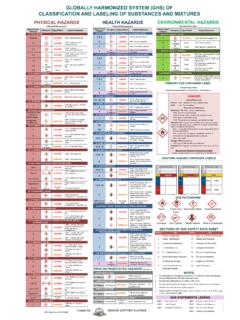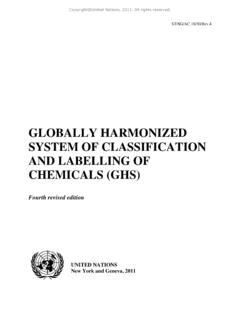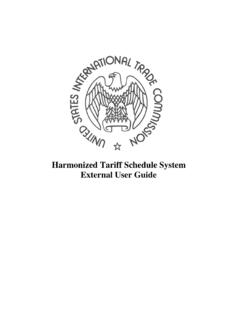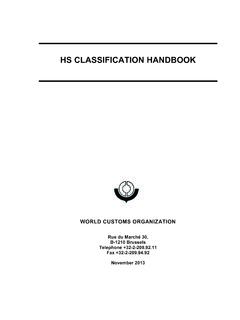Transcription of Globally Harmonized System (GHS) of Classification and ...
1 Page 1 of 3 Globally Harmonized System (GHS) of Classification and Labeling of Chemicals Produced by SCHC-OSHA Alliance GHS Information Sheet Workgroup Sept. 2007 How does the GHS compare to other regulations and consensus standards? regulatory authorities and consensus standards define Flammable and Combustible Liquids in various ways see the definitions on page 3. Certain Classification and rating systems are subject to various exceptions and qualifications that are beyond the scope of this information sheet please refer to the regulatory text for full details. Table 1 compares the classifications: Table 1: Flammable and( Combustible) Liquid Classification Comparison Flash Point Closed Cup <20 F(-7 C) 20 F(-7 C)-100 F(38 C) 100 F(38 C)-140 F(60 C) 140 F(60 C)-150 F(66 C) 150 F(66 C)- 200 F(93 C) OSHA Flammable Flammable Combustible Combustible Combustible ANSI Extremely Flammable Flammable Flammable (<141 C) Combustible Combustible RCRA (EPA)
2 Ignitable Ignitable Ignitable DOT Flammable Flammable Flammable (<141 C) Combustible Combustible CPSC Extremely Flammable Flammable Combustible Combustible NFPA 30 Class I Class I Class II Class III Class III Table 2 presents the way in which the GHS harmonizes the Flammable Liquid Criteria: Table 2: GHS Flammable (and Combustible) Liquid Criteria Criteria GHS Category Transport Class / Packing Group Flash point < 73 F(23 C) and initial boiling point < 95 F(35 C) 1 3, I Flash point < 73 F(23 C) and initial boiling point > 95 F(35 C) 2 3, II Flash point 73 F(23 C) and < 140 F( C)
3 3 3, III Flash point > 140 F( C) and < F(93 C) 4 Combustible Liquid, PG III [DOT uses <200 F(93 C)] Info Sheet #2 Flammable ( and Combustible) Liquids January, 2010 Page 2 of 3 Table 3 provides GHS label elements for Flammable (and Combustible) Liquids Table 3: GHS Label Elements for Flammable (and Combustible) Liquids Category 1 Category 2 Category 3 Category 4 Symbol No symbol Signal Word Danger Danger Warning Warning Hazard Statement Extremely flammable liquid and vapor Highly flammable liquid and vapor Flammable liquid and vapor Combustible liquid Two numerical rating systems are currently used in the United States: NFPA 704 and HMIS III.
4 Table 4 compares these rating systems to the GHS Classification System . Table 4: GHS Classifications Compared to NFPA 704 and HMIS III Rating Systems* Flammability Criteria GHS Category NFPA 704 Rating HMIS III Rating Flash point < 73 F(23 C) and initial boiling point <100 F( C) 1 or 2 4 4 Flash point < 73 F(23 C) and initial boiling point > 100 F( C) and Flash point > 73 F(23 C) and < 100 F( C) 2 or 3 3 3 Flash point 100 F( C) and < 200 F ( C) 3 or 4 2 2 Flash point > 200 F( C) and will burn in air when exposed to a temperature of 1500 F( C) for a period of 5 min. None 1 1 * HMIS is a registered trademark of the National Paint and Coatings Association (NPCA).
5 NFPA is the National Fire Protection Association To learn more .. The GHS, in its entirety (including Classification criteria and label and MSDS requirements), can be downloaded at: OSHA s Notice of Proposed Rulemaking on the GHS is available at: A 12-hour training course on the GHS is offered by the Society for Chemical Hazard Communication (SCHC): For information sheets on additional GHS topics: OSHA site: #documents - go to 'Products and Resources'. or SCHC site: - see 'GHS Information Sheets'. The OSHA Guide to the Globally Harmonized System of Classification and Labeling of Chemicals is available at: 3 of 3 The information contained in this sheet is believed to accurately represent provisions of regulations, consensus standards, and current GHS requirements.
6 However, SCHC cannot guarantee the accuracy or completeness of this information. Users are responsible for determining the suitability and appropriateness of these materials for any particular application. This sheet was developed through OSHA s Alliance Program for informational purposes only. It does not necessarily reflect the official views of OSHA or the Department of Labor. Current Definitions of Flammable and Combustible Liquids Used by Regulatory Authorities and Consensus Standards (These standards are subject to various exceptions and qualifications that are beyond the scope of this information sheet please refer to the regulatory text for full details.)
7 OSHA (Occupational Safety and Health Administration) (29 CFR ) Flammable Liquid : Any liquid having a flash point below 100 F ( C) Combustible liquid : Any liquid with a flashpoint at or above 100 F ( C), but below 200 F ( C) ANSI (American National Standards Institute) 2006 Extremely Flammable Liquid : Any liquid having a flash point at or below 20 F ( C) OR any liquid having a flash point of not more than 141 F ( C) and a boiling point of not more than 95 F (35 C) Flammable Liquid : Any liquid having a flash point of not more than 141 F ( C) and a boiling point greater than 95 F (35 C) Combustible Liquid : Any liquid having a flash point above 141 F ( C) and below 200 F ( C) RCRA (Resource Conservation & Recovery Act) - (EPA) (Environmental Protection Agency) Ignitable and spontaneously combustible OR having a flash point less than 140 F(60 C) DOT (Department of Transportation) (49 CFR ) Flammable Liquid.
8 A liquid having a flash point of not more than 141 F( C) OR Any material in a liquid phase with a flash point at or above 100 F( C) that is intentionally heated and offered for transportation or transported at or above its flash point in a bulk packaging Combustible liquid : Any liquid that does not meet the definition of any other hazard class specified in this subchapter AND has a flash point above 141 F ( C) and below 200 F (93 C) CPSC CPSC (Consumer Product Safety Commission) (16 CFR ) Extremely Flammable : Any substance with a flashpoint at or below 20 F( C) Flammable : Any substance with a flashpoint above 20 F( C) and below 100 F( C) Combustible : Any substance with a flashpoint at or above 100 F( C) to and including 150 F( C) NFPA 30 (National Fire Protection Association) (Flammable and Combustible Liquids Code) Class IA: Flash point less than 73 F(23 C); boiling point less than 100 F(38 C) Class IB: Flash point less than 73 F(23 C).
9 Boiling point equal to or greater than 100 F(38 C) Class IC: Flash point equal to or greater than 73 F(23 C), but less than 100 F(38 C) Class II: Flash point equal to or greater than 100 F(38 C), but less than 140 F(60 C) Class IIIA: Flash point equal to or greater than 140 F(60 C), but less than 200 F(93 C)







